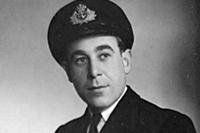The magnitude of D-Day -- the 150,000 Allied service personnel who participated, the 4,415 Allied troops killed, the 12 countries that were part of the invasion -- is plain for everyone to see, but pinning down the name's origin has proved elusive for many military historians and observers.
Some have asserted that D-Day, the June 6, 1944, amphibious assault, is short for "Decision Day" or "Designated Day," while others have surmised it stands for "Deliverance Day" or have gone a darker route to "Doomsday" or "Death Day".
Gen. Dwight D. Eisenhower once wrote of the Allied invasion of Normandy that "any amphibious operation has a 'departed date'; therefore, the shortened term 'D-Day' is used."
But retired Army Lt. Col. Mark Calhoun, a senior historian at the National WWII Museum in New Orleans, does not buy Eisenhower's explanation, reasoning that it took more than one day to load the Allies' ships and landing craft for their journey across the English Channel to fight the Germans on the beaches of France.

"Some soldiers departed a couple of days earlier than others did, so it has to be the date that you actually arrive," Calhoun told Military.com. "Otherwise, it's going to be different days."
What the "D" in D-Day actually stands for has been a source of debate almost from the time that the Allies first landed on the French coast. It is one of the most frequently asked questions tour guides get from visitors of the National WWII Museum, which was known as the National D-Day Museum when it opened in 2000.
Besides the theories already mentioned, there are also those who apparently are just fans of repetition, alliteration or both, believing the "D" stands for Day. And they would be generally correct, according to Calhoun, a former military planner who taught for 14 years at the Army's School of Advanced Military Studies at Fort Leavenworth, Kansas.
He explained that "D-Day" -- the date a military operation begins -- is a term favored by strategists in plotting out a mission when the precise date is not known. D-Day is part of a common terminology for military planners that also includes H-Hour (the hour a military operation begins -- for D-Day, it was 6:30 a.m. local time -- and M-Day (the date that mobilization for an operation begins).

Such jargon proved especially useful in the planning to invade Normandy, which Calhoun said actually began in early 1942, more than two years before Germans spotted the first Allied paratroopers on the French coast. Relying on all-encompassing terms instead of actual dates also can avoid confusion when the plan changes, such as when D-Day was originally scheduled for June 5, 1944, but pushed back a day because of a forecast for bad weather.
Adding or subtracting days from an operation's start is much easier, too, under this planning method, according to Calhoun. For example, military planners use "D-2" to mean "two days before D-Day" and "D+6" to indicate "six days after D-Day," avoiding exact dates and maintaining operational security.
"So you can't say, 'It's June 1, so this has to happen on May 1,' but you can say 'D-Day' and then you can say 'D-30,' and now you can do all of your planning and you can have this long, detailed timeline where you've got a D-Day and you've got things … that are going to have a D plus and a D minus," Calhoun explained.
"Once you finally pick your D-Day, then all you have to do is insert '6 June' where D-Day is, and then your minuses and your pluses, you can do the math and you know all the dates."
The first time that the U.S. Army is believed to have referenced a "D-Day" was on Sept. 7, 1918, about two months before World War I ended. Field Order No. 9, First Army, American Expeditionary Forces, stated: "The First Army will attack at H hour on D day with the object of forcing the evacuation of the St. Mihiel Salient [in France]." Calhoun, though, said such military terminology goes back further than that, to the mid-19th century and the Prussian general staff under Helmuth von Moltke the Elder.
World War II included other "D-Days" besides the one at Normandy, including in North Africa and Sicily, but in the public consciousness, only one invasion comes to mind. The impact of what that day represents in U.S. military, American and world history cannot be overstated, and as D-Day's anniversary approaches, those four letters still stir a sense of reverence for and pride in what the Allies endured that day.
"I have full confidence in your courage, devotion to duty and skill in battle," Eisenhower wrote in his "Order of the Day" on D-Day. "We will accept nothing less than full Victory! Good Luck and let us all beseech the blessings of Almighty God upon this great and noble undertaking."
In that message to the troops, Eisenhower never referenced "D-Day." Somehow, it didn't seem necessary.
Want to Know More About the Military?
Be sure to get the latest news about the U.S. military, as well as critical info about how to join and all the benefits of service. Subscribe to Military.com and receive customized updates delivered straight to your inbox.
























